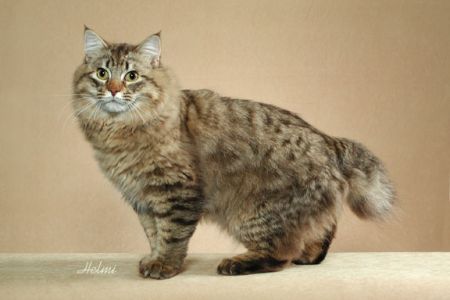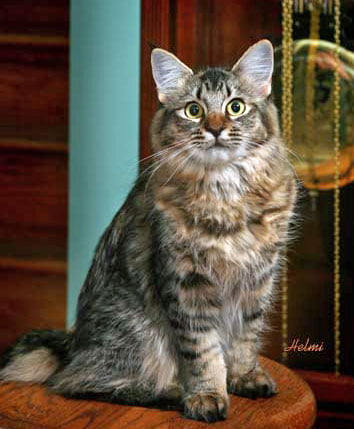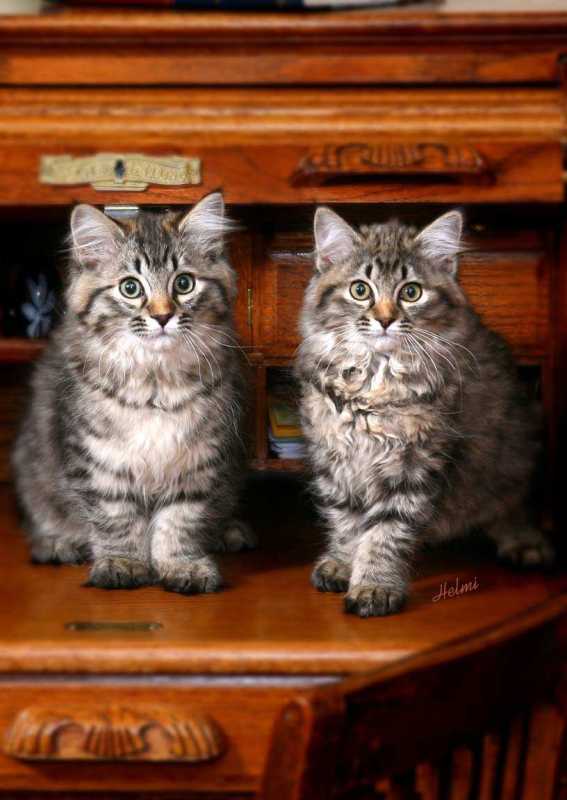The American bobtail is a brawny, hearty and wild-looking cat. The head is strong. The coat appears slightly shaggy reinforcing the natural, wild appearance. This cat can be quite large at around 15 pounds. They have a friendly temperament. There are semi-long and shorthaired varieties.
Originating in the 1960s in the US, the American bobtail was the first of two bobtailed cat breeds to be registered in America. The other is the Pixiebob. The name hints a wild parentage (a wild cat hybrid) but ‘bobcat parentage is unconfirmed’. Both Manx and Japanese bobtail genes may be present in the American bobtail. This cat’s tail should stop just above the level of the hocks and in the range 1.5 to 6 inches long. It should not be kinked.

Note: this article has been divided into several pages to make it more manageable. There are pagination links below each section to take you to the next. Sorry for the slight inconvenience but it has been done for technical reasons.

Introduction and History
As at 2009, the American Bobtail was a fairly rare and newish domestic cat breed. The short tail (at about a third to a half of the length of a normal tail3) of this breed is the result of a naturally occurring genetic mutation (perhaps a variant of the Manx mutation – dominant Manx gene) that shortens the tail. The original brown tabby Bobtail called “Yodie”, which carried the mutant gene and short tail, was found on an Indian reservation in Arizona, USA, in 1960 and adopted by John and Brenda Sanders from Iowa1. I think it is now generally accepted that Yodie was not a wild cat.

Although, there is a story that Yodie was thought to have been a wildcat hybrid (bobcat/domestic cat). Apparently Birman, Himalayan (pointed Persians) and Himalayan/Siamese cross were added to the bloodline1. Finding a feral cat with a shortened tail does not of course mean that this was the only bobtailed cat in America. They had been around for generations. It is just that the breeding of this cat began in the 1960s. This may have occurred at this time as a result of a growing interest in keeping “wild” cats as domestic cats.
For example, the beginning of the development of the Ocicat, another cat emulating a wild cat, occurred in the 1960s. There are a number of others. Although there are documented cases where the American Bobcat has mated with a domestic cat, this is not the case in this instance as no genes from the American Bobcat have been found in the American Bobtail despite the similarity in appearance. Neither is this breed to be confused with the Pixie-Bob which is a large domestic cat breed (50% larger than is usual) started in the 1980s.

There are similar uncertainties about the origins of the Pixie-Bob and whether the breed began with the mating of a wild Bobcat to a domestic cat. Pixie-Bobs have similar personalities to the Bobtail. Because the cat’s appearance was interesting to the people who found him/her the cat was mated with a long tailed cat.
The resultant offspring formed the foundation cats of this breed. Apparently, in the early years of development there were attempts to develop a bobtailed Snowshoe cat but this failed due to inbreeding1. Later work by breeders including Reaha Evans, improved the breed. Since then, it seems, feral Bobtails have been bred in North America (USA and Canada) to develop the breed and no specific breed of cat has been introduced into the breeding program.
This has resulted in a wide range of coat color and pattens together with medium-long and dense short haired varieties and possibly better health. There is also the lynx pointed Bobtail. Breeders continue to develop the breed and it is said the modern American Bobtail is sweeter in nature than previously. There is, incidentally, a Japanese Bobtail. The Japanese Bobtail genetic mutation is recessive however. The Russians have their own bobtailed cat too, the Kurilian Bobtail, allegedly a natural breed of cat.

Dominant genes results in half the litter being born with the characteristic of the mutated gene. Note also that this gene can produce what are affectionately called “rumpies” (this comes from the Manx cats, which are tailless and which are called “rumpies” “stumpies” and “tailies”). The Bobtail’s tail is unusually short, being about one third to half the length of a normal tail (see Helmi’s photographs). The tail is usually one to 4 inches in length. For the Manx cat it is normal to be tailless. But if this occurs in the Bobtail there may be accompanying health issues associated with a shortened spine. This breed has was granted full status with TICA in 2002.


With as stocky, solid and big this guy is I think he is a hybrid.
Hi Dyana. He’s a super looking cat. I love that stocky serious look.